In order to understand and evaluate the phylogenetic position of the Tibetan woolly rhinoceros within the rhinoceros subfamily, Deng Tao et al. analyzed a group containing 17 species of Rhinoceros, including all 5 living species and 12 extinct species of rhinoceros. , including all four known species of woolly rhino. In the obtained phylogenetic tree, the position of living rhinos is consistent with the analysis results of molecular biologists based on mitochondrial genome sequences and paleontologists based on morphological characteristics. However, on the issue of which species of rhinoceros is the closest to the woolly rhinoceros, the analysis by Deng Tao and others is different from previous opinions. They found that the Sumatran rhino (Dicerorhinus sumatrensis) is both the two living one-horned rhinoceros (Indian rhinoceros). The sister group of Rhinoceros unicornis and Javan rhinoceros R.sondaicus) is also the sister group of the woolly rhinoceros branch, or the two one-horned rhinoceros first formed a sister group relationship with the woolly rhinoceros branch, while the Sumatran rhinoceros is this more recent A large group of sisters. On the contrary, previous morphological analysis suggested that the woolly rhinoceros is the sister group of the African rhinoceros (black rhino, Diceros bicornis and white rhino, Ceratotherium simum), while molecular biology results indicate that the woolly rhinoceros is in a sister group relationship with the Javan rhinoceros. However, others have analyzed the woolly rhinoceros as the only extinct species. Therefore, as the number of extinct rhinoceros species is added to the phylogenetic analysis, the morphological relationship between woolly rhinoceros and living rhinoceros will inevitably be affected. If molecular data from more fossil taxa are added to the phylogenetic analysis, it is clear that the results will also change.
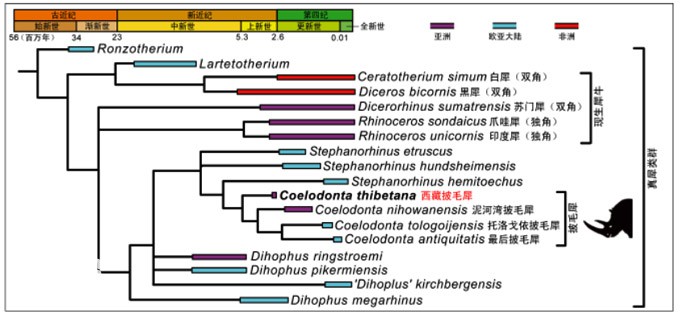
Phylogenetic relationships of woolly rhinoceros
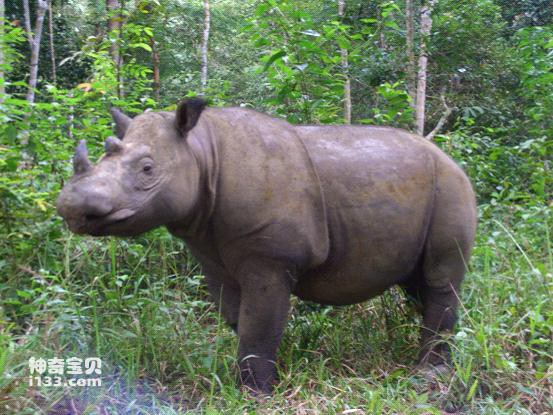
Sumatran rhinoceros
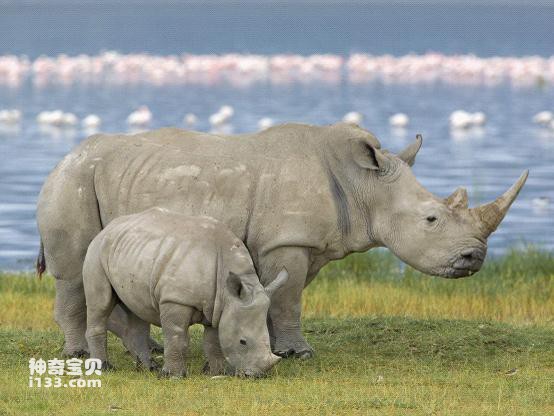
white rhinoceros
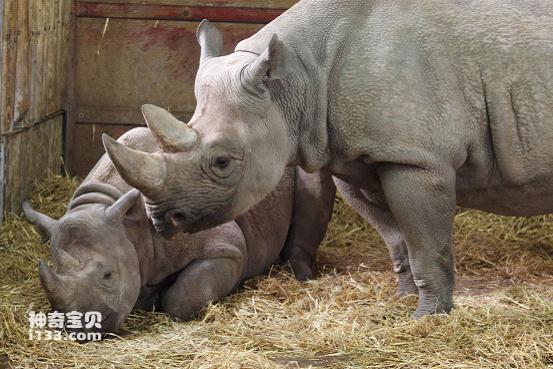
Black rhinoceros
Type 4 woolly rhinoceros
1. Tibetan woolly rhinoceros Coelodonta thibetana Deng et al., 2011
The Tibetan woolly rhinoceros was discovered in the Pliocene sediments of the Zanda Basin in the Ngari region of Tibet, about 3.7 million years ago. It is the earliest and most primitive known woolly rhinoceros. It has a series of typical characteristics of the woolly rhinoceros, including a slender head shape, an ossified nasal septum, a broad and flattened nasal horn base, a downwardly inclined nasal bone, an elevated and posterior occipital crest, a tall crown of teeth, and well-developed Dental fossa etc. On the other hand, the Tibetan woolly rhinoceros is different from other advanced woolly rhinoceros, mainly in the weak ossification of its nasal septum, which only occupies one-third of the length of the nasal notch; the forward movement of the mandibular symphysis; the surface of the cheek teeth The chalk covering is sparse, and the outer ridge is slightly folded; the middle cusp of the second upper molar is weak, and the outline of the third upper molar is triangular; the front edge of the lower front cusp of the lower cheek teeth is blunt, and the lower ridge is recurved and has a significant curvature. The posterior end of the turn; the anterior ribs of the second and third lower molars are weak, etc. The skull of the Tibetan Woolly Rhinoceros has a rather long face; the rough surface occupies the entire back of the nasal bone, indicating that it had a huge nasal horn when alive; a wide and low ridge on the frontal bone indicates that it also had a Smaller forehead. The relative size of the nasal horns is larger than that of most living and extinct rhinoceroses, and similar to that of Elasmodon and Dicrodon, but morphologically narrower. As the ice age began to appear 2.8 million years ago, the Tibetan woolly rhinoceros left the plateau, passed through some intermediate stages, and finally came to the low-altitude and high-latitude areas of northern Eurasia. The mammoth-an important member of the woolly rhinoceros fauna that flourished in the late Pleistocene.
2. Coelodonta nihowanensis Kahlke, 1969
The Nihewan woolly rhinoceros lived in the Early Pleistocene period 2.6 to 2 million years ago. It was first discovered in the Nihewan Basin in Yangyuan County, Hebei Province, and was later found in Linyi County, Shanxi Province and Gonghe County, Qinghai Province. The most complete skull and mandible materials were found in the Wucheng loess of Dongxiang County in the Linxia Basin of Gansu Province. It is a small and primitive woolly rhinoceros. The skull is not particularly narrow and long, with the head base and occipital length being about 65 cm; the face is relatively short, and the length of the face before the orbits is about 7/10 of the length of the brain after the orbits; the front end of the nasal bone is arc-shaped and is far away from the premaxillary bone. ; The distance from the nasal notch to the anterior orbital rim is extremely short, and the anterior orbital rim is located in front of the third molar; the zygomatic arch is curved; the occipital roof is not particularly strongly retroverted. The vertical ramus of the mandible is also not strongly retroverted. The lower incisors still have alveoli in adults; the chalk covering on the cheek teeth is very thin; the upper and lower premolars, especially the lower second premolars, are relatively large; the upper third molars are triangular.
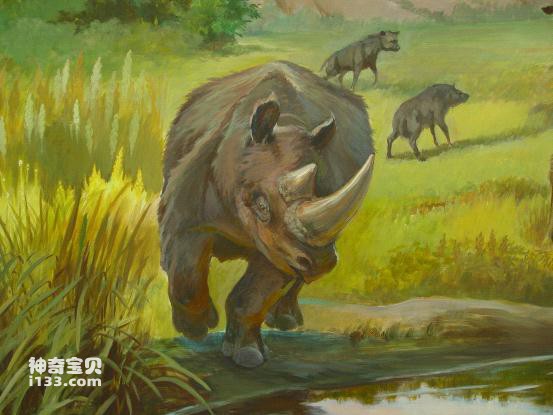
Nihewan woolly rhinoceros recovery map
3. Coelodonta tologoijensis Beljaeva, 1966
The Tologoi woolly rhinoceros was first discovered in Tologoi near Ulan-Ude on the east coast of Lake Baikal in Russia. Later it was reported that it was also found near Ulaanbaatar in Mongolia and Thuringia, Germany in central Europe. It was the first to survive. The era is 750,000 years ago in the middle Pleistocene, and spread from Siberia to Europe 460,000 years ago. Its skull is relatively broad and short, the occipital surface is tilted backward, the occipital ridge hangs above the occipital condyle, and the occipital part is significantly narrower than the frontal bone part of the top of the head; the zygomatic arch is strongly curved; the orbital position is quite high, almost close to the frontal surface; the end of the nasal bone It tilts downward, and the nasal horn seat above it also tilts forward; the rough nasal horn seat occupies the entire nasal bone surface, and the frontal horn seat also spans the width of the frontal bone; the back of the skull is relatively long. The front of the upper cheek dentition is significantly flared outwards, and the complex structure of the teeth indicates that it further developed a habit of feeding entirely on herbaceous plants. The limb bones of Tologoi's woolly rhinoceros also evolved simultaneously with the skull, and are characterized by being slender and good at running.
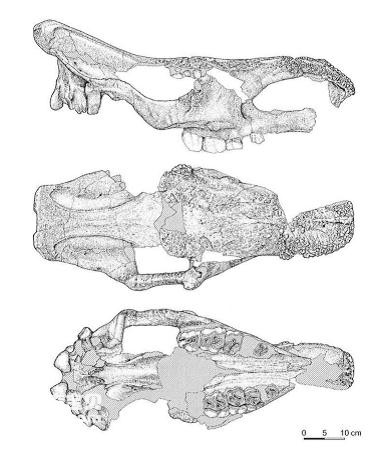
Tologoi woolly rhinoceros skull
4. The last woolly rhinoceros, Coelodonta antiquitatis (Blummenbach, 1799)
Finally, the woolly rhinoceros lived in the late Pleistocene. It is the most widely distributed woolly rhinoceros, with fossils found throughout northern Eurasia from the Korean Peninsula in East Asia to Scotland in Europe. It did not become extinct until 10,000 years ago. . Its fossils are also very abundant in Northeast China and other places, with typical locations such as Yushu County in Jilin Province and the Sarawusu area in Inner Mongolia. It is one of the most famous Ice Age animals, with a very thick skeleton, thick fur and huge nose horns, making it the largest of all woolly rhinoceroses. Paleontologists know the physical anatomy of the woolly rhinoceros very well, because some mummies have been found in tundra or asphalt deposits, which also preserved their blanket-like hair that covered their bodies and their boneless horns. No other rhinoceros horns have been preserved as fossils. Primitive humans once lived together with woolly rhinoceros. They drew images of woolly rhinoceros on cave paintings, leaving behind what the woolly rhinoceros looked like when they lived.

Woolly rhinoceros as depicted on cave paintings by Stone Age humans
animal tags: rhinoceros
We created this article in conjunction with AI technology, then made sure it was fact-checked and edited by a Animals Top editor.